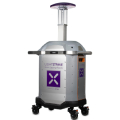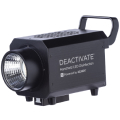Peggy ended up in the emergency department one week after her root canal. The healthcare team there discovered she had sepsis (a bloodstream infection) caused by the bacteria Clostridioides difficile (C. diff). C. diff is a spore-forming bacterium that causes life-threatening diarrhea and inflammation of the colon. Peggy’s healthcare team tried everything they could to save her life, but she died from C. diff a week after the dental procedure.
November is C. diff Awareness Month.
During this month we honor our loved ones lost to C. diff by raising awareness of the impact C. diff has had on us, our families and those we care about. To honor their mom, Peggy Lillis’ children started the non-profit Peggy Lillis Foundation to educate the public, empower advocates, and help shape policy with the goal to make C. diff rare, treatable, and survivable. The Peggy Lillis Foundation provides resources and support to help patients and their families, as well as healthcare workers, raising awareness to stop the spread of C. diff. Visit the Peggy Lillis Foundation website to get resources, learn about the latest campaign, sign a petition, see upcoming events, or read patient stories at: https://peggyfoundation.org
Unfortunately, stories like Peggy’s happen all too often.
The CDC classifies C. diff as an urgent public health threat [1]. Each year 500,00 people become ill with C. diff and 29,300 die [2]. Even after recovery, C. diff can colonize or remain in the patient’s body. About 1 in 5 patients who have recovered from C. diff will experience infection again [2]. Two important factors for C. diff infections in healthcare settings are inappropriate or unnecessary antibiotic use and hygiene [3]. Every year patients, such as Peggy, are prescribed unnecessary or inappropriate antibiotics. This exerts evolutionary pressure on the bacteria in the human body. For example, a minority resistant bacterium like C. diff can find itself at a competitive advantage in the environment, as the susceptible majority bacteria are killed off by antibiotics. People on antibiotics are 7 to 10 times more likely to get C. diff during the course of their therapy and the month after [4]. C. diff is not resistant to antibiotics, but it can spore or develop a tough outer shell that protects it from environmental conditions [4]. C. diff spores can survive on hands, inanimate objects, and high touch surfaces throughout the healthcare setting [5,6]. C. diff spores can also resist ethanol, hydrogen peroxide, chloroform, and heat [7]. Bottomline: C. diff is one tough superbug!
Antimicrobial stewardship, hand hygiene, and environmental cleanliness remain frontline strategies for combating C. diff in healthcare settings.
Antimicrobial stewardship programs promote the safe and effective use of antibiotic therapies. These programs can reduce the number of unnecessary or inappropriate antibiotics prescriptions by changing clinical practice and pharmacy processes [3]. For example, evidence-based guidelines recommend that patients, like Peggy, are not prescribed antibiotics for dental procedures [8], and that physicians should not prescribe anti-diarrhea medicine if a patient has suspected C. diff infection (e.g. diarrhea, fever, stomach pain, and taking antibiotics) [3]. Antimicrobial stewardship programs use evidence-based practices that are proven effective in stopping the spread of C. diff.
Hand hygiene is an important strategy for stopping the spread of C. diff. Wash hands with warm water and soap for at least 60 seconds [9]. Healthcare workers, patients and families need to practice good hand hygiene. Research has shown that healthcare workers can pick up C. diff from patients or the environment, and inadvertently spread infection to others [5]. The World Health Organization has defined five key moments when healthcare workers should perform hand hygiene: before touching a patient, before a clean/aseptic procedure, after exposure to bodily fluids, after touching the patient, and after touching the patient surroundings [9]. This simple evidence-based approach to hand hygiene can help stop C. diff in its tracks.
Environmental hygiene can help cut the transmission of C. diff from the environment to healthcare worker’s hands or the patient [10]. When a patient is infected or colonized with C. diff they shed bacteria into the environment around them [10]. To remove harmful pathogens from the environment, cleaning staff must thoroughly clean and disinfect every surface. This is where ultraviolet (UV) light disinfection can help. Wavelengths of UV light can deactivate bacteria like C. diff [11]. LightStrike uses a patented Pulsed Xenon UV light system that produces UV across the entire germicidal spectrum (200-315 nm) where spores and bacteria are most susceptible [11]. Research has found that LightStrike Robots can deactivate C. diff left behind after manual cleaning [12,13]. Hospitals can use LightStrike as part of a comprehensive infection control program to reduce the presence of harmful pathogens in the environment that can be a source or cause of infection.
References
- Centers for Disease Control and Prevention (CDC). Antibiotic Resistance Threats in the United States, 2019. Atlanta, GA: U.S. Department of Health and Human Services. Retrieved from: https://www.cdc.gov/drugresistance/pdf/threats-report/2019-ar-threats-report-508.pdf, November 10, 2020.
- Guh AY, Mu Y, Winston LG, Johnston H, Olson D, Farley MM, Wilson LE, Holzbauer SM, Phipps EC, Dumyati GK, Beldavs ZG. Trends in US burden of Clostridioides difficile infection and outcomes. New England Journal of Medicine. 2020 Apr 2;382(14):1320-30.
- McDonald LC, Gerding DN, Johnson S, Bakken JS, Carroll KC, Coffin SE, Dubberke ER, Garey KW, Gould CV, Kelly C, Loo V. Clinical practice guidelines for Clostridium difficile infection in adults and children: 2017 update by the Infectious Diseases Society of America (IDSA) and Society for Healthcare Epidemiology of America (SHEA). Clinical Infectious Diseases. 2018 Mar 19;66(7):e1-48.
- Hensgens MP, Goorhuis A, Dekkers OM, Kuijper EJ. Time interval of increased risk for Clostridium difficile infection after exposure to antibiotics. Journal of Antimicrobial Chemotherapy. 2012 Mar 1;67(3):742-8.
- Jinadatha C, Villamaria FC, Coppin JD, Dale CR, Williams MD, Whitworth R, Stibich M. Interaction of healthcare worker hands and portable medical equipment: a sequence analysis to show potential transmission opportunities. BMC Infectious Diseases. 2017 Dec 1;17(1):800
- Aliramezani A, Talebi M, Golbabaei F, Baghani A, Marjani M, Afhami S, Hajabdolbaghi M, Boroumand MA, Kuijper EJ, Douraghi M. Characterization of Clostridioides difficile isolates recovered from hospitalized patients and the hospitals environment and air: A multicenter study. Anaerobe. 2019 Oct 1;59:154-8.
- Edwards AN, Karim ST, Pascual RA, Jowhar LM, Anderson SE, McBride SM. Chemical and stress resistances of Clostridium difficile spores and vegetative cells. Frontiers in Microbiology. 2016 Oct 26;7:1698.
- American Dental Association. Oral health topics: Antibiotic prophylaxis prior to dental procedures. Retrieved from: https://www.ada.org/en/member-center/oral-health-topics/antibiotic-prophylaxis, November 10, 2020.
- Pittet D, Allegranzi B, Boyce J, World Health Organization World Alliance for Patient Safety First Global Patient Safety Challenge Core Group of Experts. The World Health Organization guidelines on hand hygiene in health care and their consensus recommendations. Infection Control & Hospital Epidemiology. 2009 Jul;30(7):611-22.
- Jullian-Desayes I, Landelle C, Mallaret MR, Brun-Buisson C, Barbut F. Clostridium difficile contamination of health care workers’ hands and its potential contribution to the spread of infection: Review of the literature. American Journal of Infection Control. 2017 Jan 1;45(1):51-8.
- Taylor W, Camilleri E, Craft DL, Korza G, Granados MR, Peterson J, Szczpaniak R, Weller SK, Moeller R, Douki T, Mok WW. DNA damage kills bacterial spores and cells exposed to 222-nanometer UV radiation. Applied and Environmental Microbiology. 2020 Apr 1;86(8).
- Ghantoji SS, Stibich M, Stachowiak J, Cantu S, Adachi JA, Raad II, Chemaly RF. Non-inferiority of pulsed xenon UV light versus bleach for reducing environmental Clostridium difficile contamination on high-touch surfaces in Clostridium difficile infection isolation rooms. Journal of Medical Microbiology. 2015 Feb 1;64(Pt 2):191.
- Kitagawa H, Mori M, Hara T, Kashiyama S, Shigemoto N, Ohge H. Effectiveness of pulsed xenon ultraviolet disinfection for Clostridioides (Clostridium) difficile surface contamination in a Japanese hospital. American Journal of Infection Control. 2020 May 30.

















